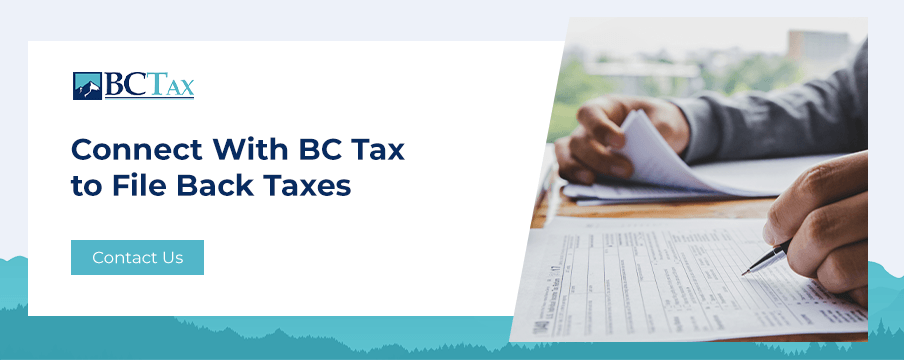The Internal Revenue Service (IRS) reports show that 11 million delinquent accounts in 2023 owed a combined $150 million in taxes, penalties and interest. Owing money to the IRS can cause persistent stress and spiral into larger debt.
Filing your back taxes is the first step back to peace of mind and financial security, even if you have already missed returns for a few years. Some people avoid filing back taxes after missing one return. Soon, one year turns into a couple and a couple into a few. Putting off back tax filing only causes more trouble because, whatever you do, the IRS will come to collect. Penalties and interest will just pile up, making it harder to achieve resolution.
If you owe taxes, it’s time to get back on track and reorganize your finances. You can start by filing your back taxes even if you cannot pay the balance in full. But how do you start filing your back taxes? The thought of it might be intimidating, but with time, effort and help from a tax consultant or an enrolled agent, you can achieve the peace of mind you deserve. BC Tax helps individuals in any tax bracket resolve IRS debt of any amount. We’ll be there every step of the way as you watch your balance shrink to zero.
7 Steps to File Your Back Taxes
Getting back on track is possible, even if you owe multiple years of taxes, penalties and interest to the IRS. Follow these steps to file your back taxes and resume good financial standing.
1. Consider Hiring an Enrolled Agent for Back Tax Filing Assistance
IRS debt resolution is a demanding process for anyone. Fortunately, there are people who can help. Hiring an enrolled agent is the best way to file back taxes.
An enrolled agent is a tax advisor with federal authorization through the United States Department of the Treasury to represent taxpayers through IRS interactions. From appealing your debt to negotiating a repayment strategy with the IRS, an enrolled agent can expedite your back tax filing process and ensure you comply with its most acute details.
You can hire an enrolled agent through an agency like BC Tax. A dedicated agent will leverage all of their resources to clear the path as you navigate the back tax filing process.
2. Gather All Your Tax Documents
Whether working with an enrolled agent or filing back taxes on your own, compiling your documents for each year you missed is one of the first steps to take. You need to get your tax records ready so that you can complete subsequent steps and clear any misunderstandings. The important documents to gather include your last tax return, W-2 and other documents that verify your income. Gather expense documentation as well, such as receipts, 1099 forms or other supporting records for your deductions.
If you don’t have the necessary forms, you can file back taxes without records on hand by calling the IRS at 1-800-829-1040.

3. Prepare Your Tax Return
Using all the documents you have gathered, you now have to prepare your returns for each year you have missed. This can be a tedious process that may exemplify the value of hiring a tax expert for assistance.
Tax professionals know their way around federal tax codes. They might be able to secure more deductions or write-offs when preparing your tax return. Also, since tax laws change every now and then, you might need to follow different rules for each year’s taxes you file. Professionals like the agents at BC Tax can maximize your return and prevent you from getting into a deeper hole.
4. Be Wary of Your Refunds
Even if you have filed your returns late, it is still possible to get refunds if you do not owe taxes. However, you only have three years to claim the refund and then it’s gone. Make note of the eligible dates and possible refunds so that you can plan ahead for the next tax season. This way, you can prevent the IRS from forfeiting your refunds.
5. Pay Your Debts
The main reason why you’re following these back tax filing steps is to comply with the tax law. Payment is the top compliance priority. Now, after you prepare and file your returns, pay all the tax debt that you owe. Be prepared for penalties, interests and other consequences of your failure to file it on time.
6. Set Up a Payment Plan
Your tax debt may have grown after accumulating years of penalties and interest. If you cannot pay the tax in full, don’t despair. You still did well by filing your taxes, and you have now opened doors of opportunities to fix your problems. It’s common and possible to divide your balance into installments.
After filing your return, you can negotiate with the IRS to come to an installment agreement, offer in compromise or another tax penalty abatement option. The IRS offers the Fresh Start program to provide tax balance resolution options for individuals and businesses. An experienced tax agent like those at BC Tax can help you identify and follow through with tax forgiveness opportunities most relevant to your situation.
7. Plan Ahead
Now that you’re back on track, it’s time to create a tax plan that ensures you keep up with your future tax obligations. Take a look at your finances to determine how you can reduce the taxes you owe in future years, pay taxes you still owe today and establish a budget that helps you manage it all. There are numerous angles to consider in tax planning. A tax accountant can cover them all.
Connect With BC Tax to File Back Taxes
Filing back taxes is manageable — especially with support from professional tax accountants. The enrolled agents and tax accountants at BC Tax can get you back on your feet quickly. Our various tax services can solve your current problems and help you avoid roadblocks in the future. Contact us online for more on our tax resolution capabilities.

 1-800-548-4639
1-800-548-4639









